高级综合商务英语1-Unit-10-career-planning-彭青龙
- 格式:ppt
- 大小:2.15 MB
- 文档页数:10
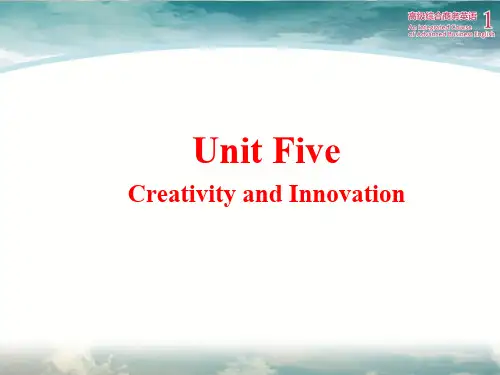

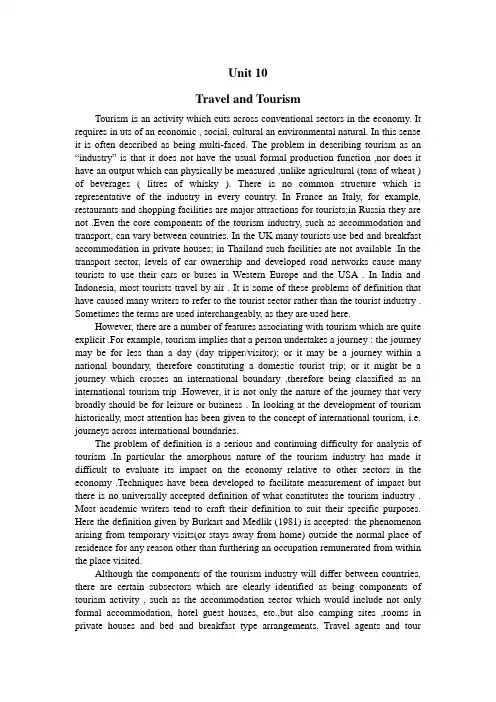
Unit 10Travel and TourismTourism is an activity which cuts across conventional sectors in the economy. It requires in uts of an economic , social, cultural an environmental natural. In this sense it is often described as being multi-faced. The problem in describing tourism as an “industry” is that it does not have the usual formal production function ,nor does it have an output which can physically be measured ,unlike agricultural (tons of wheat ) of beverages ( litres of whisky ). There is no common structure which is representative of the industry in every country. In France an Italy, for example, restaurants and shopping facilities are major attractions for tourists;in Russia they are not .Even the core components of the tourism industry, such as accommodation and transport, can vary between countries. In the UK many tourists use bed and breakfast accommodation in private houses; in Thailand such facilities ate not available .In the transport sector, levels of car ownership and developed road networks cause many tourists to use their cars or buses in Western Europe and the USA . In India and Indonesia, most tourists travel by air . It is some of these problems of definition that have caused many writers to refer to the tourist sector rather than the tourist industry . Sometimes the terms are used interchangeably, as they are used here.However, there are a number of features associating with tourism which are quite explicit .For example, tourism implies that a person undertakes a journey : the journey may be for less than a day (day tripper/visitor); or it may be a journey within a national boundary, therefore constituting a domestic tourist trip; or it might be a journey which crosses an international boundary ,therefore being classified as an international tourism trip .However, it is not only the nature of the journey that very broadly should be for leisure or business . In looking at the development of tourism historically, most attention has been given to the concept of international tourism, i.e. journeys across international boundaries.The problem of definition is a serious and continuing difficulty for analysis of tourism .In particular the amorphous nature of the tourism industry has made it difficult to evaluate its impact on the economy relative to other sectors in the economy .Techniques have been developed to facilitate measurement of impact but there is no universally accepted definition of what constitutes the tourism industry . Most academic writers tend to craft their definition to suit their specific purposes. Here the definition given by Burkart and Medlik (1981) is accepted: the phenomenon arising from temporary visits(or stays away from home) outside the normal place of residence for any reason other than furthering an occupation remunerated from within the place visited.Although the components of the tourism industry will differ between countries, there are certain subsectors which are clearly identified as being components of tourism activity , such as the accommodation sector which would include not only formal accommodation, hotel guest houses, etc.,but also camping sites ,rooms in private houses and bed and breakfast type arrangements. Travel agents and touroperators are recognized as comprising another distinct subsector. Transport-airlines, shipping, rail and cat hire, cars and coaches—will also be seem as being important inputs to the tourism sector . In some countries,shopping and production of handicrafts is another associated activity of tourism.If we use 1945 as being the year when the development of the major growth in the tourism industry began , we can make some general observations relating to the changes which one can discern in the tourism industry.Before the 1950s ,tourism was very much an industry which was fragmented; hotels, transport operators ,travel agents , tour operators all tended to work independently of each other. Hotels were largely in the business of selling bed nights. Airlines and railways were in the business of selling seats. Travel agents , of course , were selling travel and holidays . But in each case they tended to operate very much as individual businesses. From the mid-1950s onwards , particularly in the UK, the growth of tour operators began to change the mature of the industry from essentially individual business activities to more integrated activities. Hotels, for example, were beginning to see customers as wanting a range of services rather than simple buying accommodation. So hotels began to develop shopping arcades and later to offer secretarial centres to try to increase the spending of guests within the hotel complex. Transport services as being integral to a much wider need. Airlines offered insurance and accommodation booking travel services including holiday arrangements, medical services, car hire, etc.What we have seem since the 1950s is the emergence of a holiday and travel industry which is offering more integrated services. This is particularly noticeable with the forward and backward integration of some of the very large tour operators. To some extent this was determined by the nature of demand. In other cases it was a business opportunity to integrate demand and provide a service at a much more competitive price and to maintain and increase market share. By 1990the structure of the tourism industry ,certainly in the UK and Europe , was influenced by the growth of some very large companies. In the USA, American anti-trust laws discouraged, if not prohibited, the development of large integrated companies. The American experience in tour operation has been very different from that within Europe, particularly compared with the UK.As the structure of service provision changed, so did the nature of holiday taking. Up until 1946, i.e. the period between the world wars, much of international travel was for the privileged, wealthy and elite groups in society. From 1950 onwards a combination of factors, for example, increase in leisure time availability, increase in paid holidays, development of package tours, development in air transport—all combined to provide a much wider potential holiday-taking market. This market was different in terms of socioeconomic groups from the pre-1950 era.The changing nature of holiday was reflected in the social groups taking holidays, and in the distances which people were prepared to travel to holiday destinations. One of the major demand changes was the increased availability of leisure for a wider group in society. Rising real incomes, paid holidays and growing propensity to demand foreign holidays, or a combination of these, were important and continuingfactors stimulating international tourism demand. These factors were not simple economic determinants but also social ones. As the world recovered from the Second World War there was growing evidence to indicate that people were spending more time on leisure activities and on travel. These tendencies were reflected in the protection that many people gave to holiday expenditures, these expenditures being the last to be surrendered in the face of income changes.We can conclude that , especially since 1945, tourism has developed into a significant international industry. As it has developed it has also become more specialized, with vertical and horizontal company amalgamations creating different scales of operation in various market segments. The growth in international airlines of operation in various market segments. The growth in international airlines, advances in information technology and the growth flexibility in inclusive tour arrangements have all contributed to the present structure and characteristics of the tourism industry.。
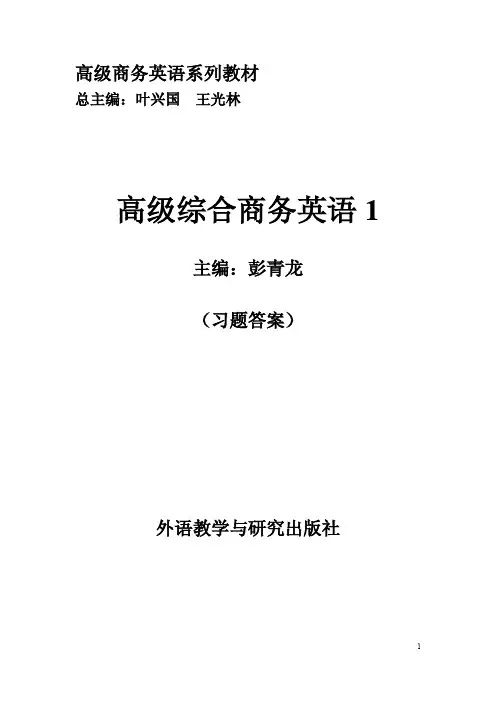
高级商务英语系列教材总主编:叶兴国王光林高级综合商务英语1主编:彭青龙(习题答案)外语教学与研究出版社Unit 1 GlobalizationLead-in1. Quiz1) B 2) C 3) D 4) A 5) A2. A Mini CaseSuggested answers:●As Zara continues to expand, it might have to open other distribution centers onother continents. Language, culture, and work relations may vary significantly from the closely-managed operation currently in place in Spain. The company may run into more specific challenges in accommodating customers‘requirements due to a lack of cultural sensitivity. Zara‘s expansion globally may pose the challenge of moving from a more centralized management style to a more global style.●Lorena needs to ensure that she has a truly international team in place withmembers from both multilingual and multicultural background; draw up a plan on how global logistics will support global expansion; start a succession plan and train new logistics managers who could be ready to take on overseas responsibilities; and encourage store managers to include suggestions on cultural specifics which may help in making the final product and brand expansion successful.Text AI.Reading Comprehension1.Determine whether the following statements are true or false. Write a T fortrue, an F for false, and an NG for not given.1) T 2) F 3) T 4) F 5) F 6) T 7) T 8) F 9) T 10) NG2.Essay Questions1)The modern multinational companies have had passed through three phases. Firstcame the 19th-century ―international model‖, with firms based in their home country and selling goods through overseas sales offices. This was followed by the classic multinational firm in which the parent company created smaller versions of itself in countries around the world. And now it has been replaced by a single integrated global entity in which the firm will move people and jobs anywhere in the world, based on the right cost, the right skills and the right business environment.2)The big attractions from emerging markets are low-cost labor, highly skilledpersonnel, and a chance to cooperate with the government as a potential customer.3)They are lacking the management talents who can practice and support businessoperating models that will allow them to generate profitable growth in more mature markets over the long term.4)The single biggest challenge facing Western multinationals is the lack ofemerging-market experience in their senior ranks. Moreover, multinationals have great trouble retaining the managers they do have in emerging markets.―Well-trained, good, honest people are scarce in emerging markets. Multinationals are better at training these people than emerging-market companies, which prefer to poach them once they are trained.‖II.Blank-filling: Complete the following sentences with the words given in the box. Change the form when necessary.1) cutting-edge 2) commoditized 3) aggressive 4) forge 5) benchmark 6) blueprint 7) expatriates 8) deploy 9) ferocious 10) substantial III.Paraphrasing1.Rewriting: Rewrite the underlined part of each sentence in your own words.1) ―In the 97 years of the company‘s history, never had a particular kind of product or merchandise been managed outside the U.S.,‖he says excitedly, noting that ―Latin America now reports to Shanghai.‖2) But the assault on its services business led by a trio of Indian outsourcing upstarts, Tata Consulting Services, Infosys and Wipro, posed a big threat to the field that might be the main sources of growth for the company as expected by Mr. Palmisano.3) In many emerging markets the most attractive potential customer is the government, because of the government‘s urgent needs to improve the infrastructure facilities in a wide range, from the mobile telephone networks to roads, airports and ports, energy and water supply.4) A 2007 study of China‘s top 200 publicly traded companies found that it is still difficult even for the leading companies in China to compete with those global giants.5) American multinationals now have a ―ferocious interest in attracting non-Americans to the board‖, but they can find only a few qualified executives from the European countries, not to mention those from emerging markets.2. Sentence Transformation: Complete the following sentences based on the structures given.1) Because of the fact that hot labor markets in emerging markets are causing extremely high turnover rates, every big multinational is aiming to win the ―war for talent‖ and taking it as one of the most urgent issues.2) It is believed that as a big multinational company it enjoys advantages in recruiting and retaining talented managers than the local competitors.3) Despite the growth of their revenue which increased on the back of China‘s continued economic growth, they could only create half of the value of their global competitors.4) No longer the ―young bucks or retirement-posing types‖as they used to be,nowadays the expatriate managers appointed by multinationals to work in emerging markets are generally of a much higher quality.5) Compared with those old multinationals, the firms in emerging markets are typically lacking the depth of management talent, though the founders are often impressive.IV.Translation1.Sentence Translation1) 这一雄心勃勃的策略是对来自新兴市场的激烈竞争做出的回应。
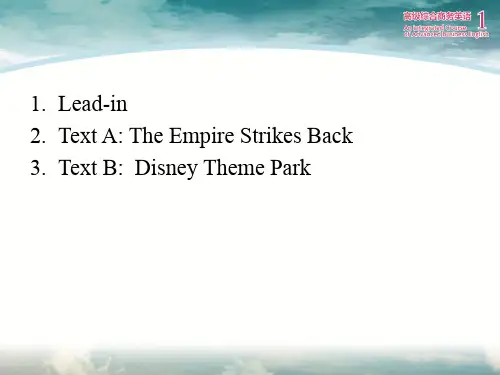
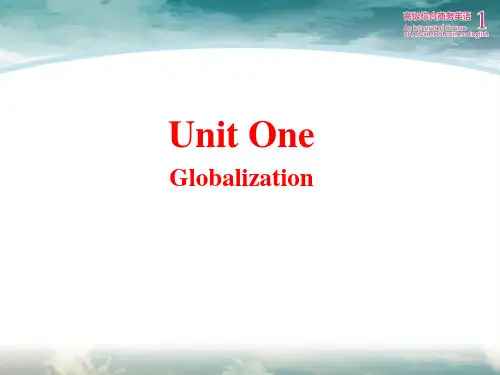
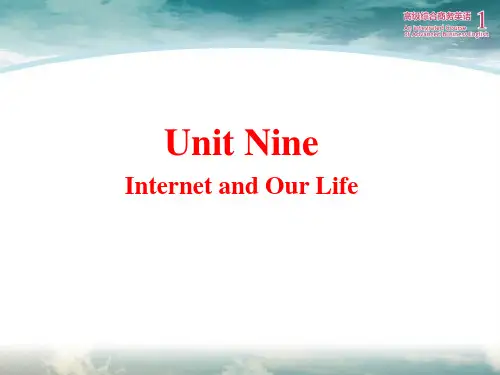


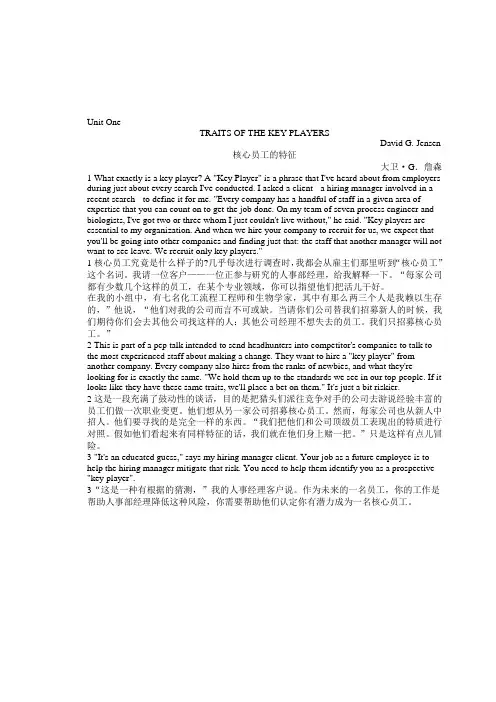
Unit OneTRAITS OF THE KEY PLAYERSDavid G. Jensen核心员工的特征大卫·G.詹森1 What exactly is a key player? A "Key Player" is a phrase that I've heard about from employers during just about every search I've conducted. I asked a client - a hiring manager involved in a recent search - to define it for me. "Every company has a handful of staff in a given area of expertise that you can count on to get the job done. On my team of seven process engineer and biologists, I've got two or three whom I just couldn't live without," he said. "Key players are essential to my organization. And when we hire your company to recruit for us, we expect that you'll be going into other companies and finding just that: the staff that another manager will not want to see leave. We recruit only key players."1核心员工究竟是什么样子的?几乎每次进行调查时,我都会从雇主们那里听到“核心员工”这个名词。
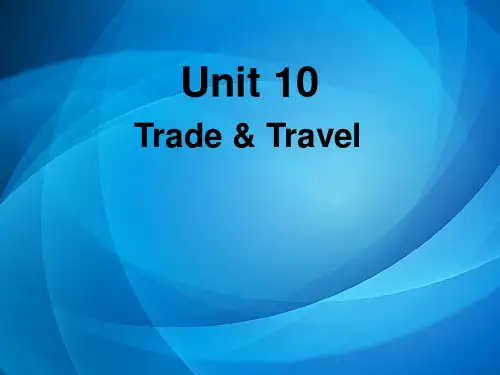
大学商务英语写作彭青龙华东师范大学课后答案1、72.—? ? ? ? ? ? ? ? ? ? ? ??—Yes, please. I want a sweater. [单选题] *A.How muchB.Can I help you(正确答案)C.Excuse meD.What will you take2、He was very excited to read the news _____ Mo Yan had won the Nobel Prize for literature [单选题] *A. whichB. whatC. howD. that(正确答案)3、There ______ a football match and a concert this weekend.()[单选题] *A. isB. haveC. will be(正确答案)D. will have4、It seems slow for children to become _____ ,while adults often feel time flies. [单选题] *A. growns-upsB. growns-upC. grown upsD. grown-ups(正确答案)5、The language school started a new()to help young learners with reading and writing. [单选题] *A. course(正确答案)B. designC. eventD. progress6、Could you tell me _____ to fly from Chicago to New York? [单选题] *A.it costs how muchB. how much does it costC. how much costs itD.how much it costs(正确答案)7、How beautiful the flowers are! Let’s take some _______. [单选题] *A. photos(正确答案)B. potatoesC. paintingsD. tomatoes8、When you have trouble, you can _______ the police. They will help you. [单选题] *A. turn offB. turn to(正确答案)C. turn onD. turn over9、Guilin is _______ its beautiful scenery. [单选题] *A. famous for(正确答案)B. interested inC. fond ofD. careful with10、We had ____ wonderful lunch last Saturday. [单选题] *A. /B. theC. oneD. a(正确答案)11、This is the news _______ you want to know. [单选题] *A. that(正确答案)B. whatC. whenD. who12、The little girl held _____ in her hand. [单选题] *A. five breadsB. five piece of breadsC. five piece of breadD. five pieces of bread(正确答案)13、Galileo was ____ Italian physicist and astronomer who invented _____ telescope. [单选题] *A. a, aB. the, theC. an, aD. an, the(正确答案)14、I _______ play the game well. [单选题] *A. mustB. can(正确答案)C. wouldD. will15、How I wish I()to repair the watch! I only made it worse. [单选题] *A. had triedB. hadn't tried(正确答案)C. have triedD.didn't try16、Mrs. Black is on her way to England. She will _______ in London on Sunday afternoon. [单选题] *A. reachB. attendC. arrive(正确答案)D. get17、--Do you often go to the cinema _______ Sunday?--No, we _______. [单选题] *A. on; don’t(正确答案)B. on; aren’tC. in; doD. in; don’t18、I’m so tired after _______ walk. [单选题] *A. three hour’sB. three hours’(正确答案)C. three hoursD. three hour19、46.The pants look cool.You can ________. [单选题] *A.try it onB.try on itC.try them on(正确答案)D.try on them20、So many people will _______ to their work after the Spring Festival. [单选题] *A. get inB. get onC. get offD. get back(正确答案)21、Both Mary and Linda don't care for fish. [单选题] *A. 喜欢(正确答案)B. 关心C. 照料D. 在乎22、49.________ is the price of the product? [单选题] *A.HowB.How muchC.What(正确答案)D.How many23、( ) ________ large the library is! [单选题] *A. WhatB. What aC. How(正确答案)D. How a24、Tomorrow is Ann’s birthday. Her mother is going to make a _______ meal for her. [单选题] *A. commonB. quickC. special(正确答案)D. simple25、It was _____ that the policy of reform and opening up came into being in China. [单选题] *A. in the 1970s(正确答案)B. in 1970sC. in the 1970s'D. in 1970's26、78.According to a report on Daily Mail, it’s on Wednesday()people start feeling really unhappy. [单选题] *A. whenB. whichC. whatD. that(正确答案)27、pencil - box is beautiful. But ____ is more beautiful than ____. [单选题] *A. Tom's; my; heB. Tom's; mine; his(正确答案)C. Tom's; mine; himD. Tom's; my; his28、_____how to do with the trouble of the computer, Tom had to ask his brother for help. [单选题] *A.Not to knowB.Not knowing(正确答案)C.Not knownD.Not know29、I knocked on the door but _______ answered. [单选题] *A. somebodyB. anybodyC. nobody(正确答案)D. everybody30、We have _______ a double room with a bath for you in the hotel. [单选题] *A. boughtB. reserved(正确答案)C. madeD. taken。